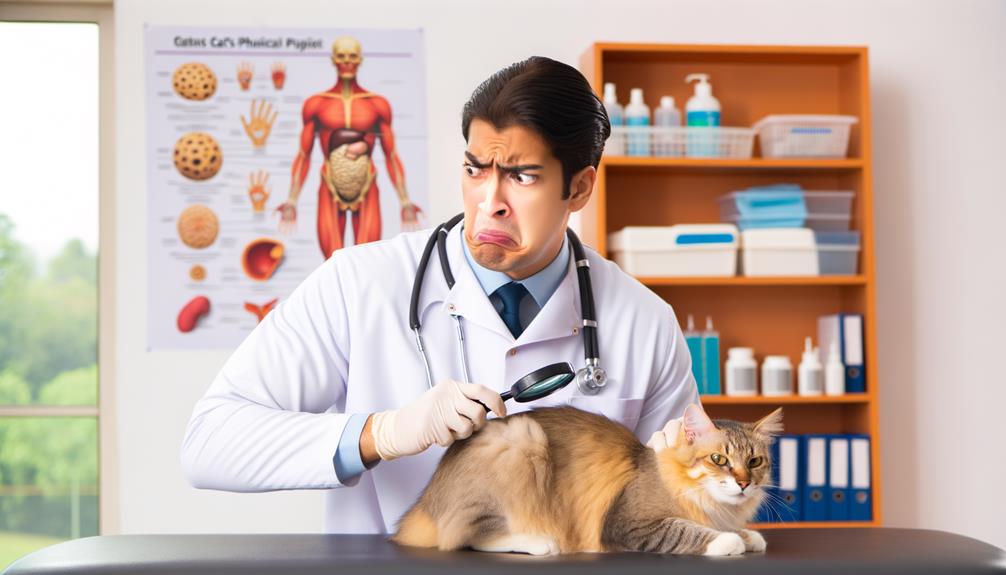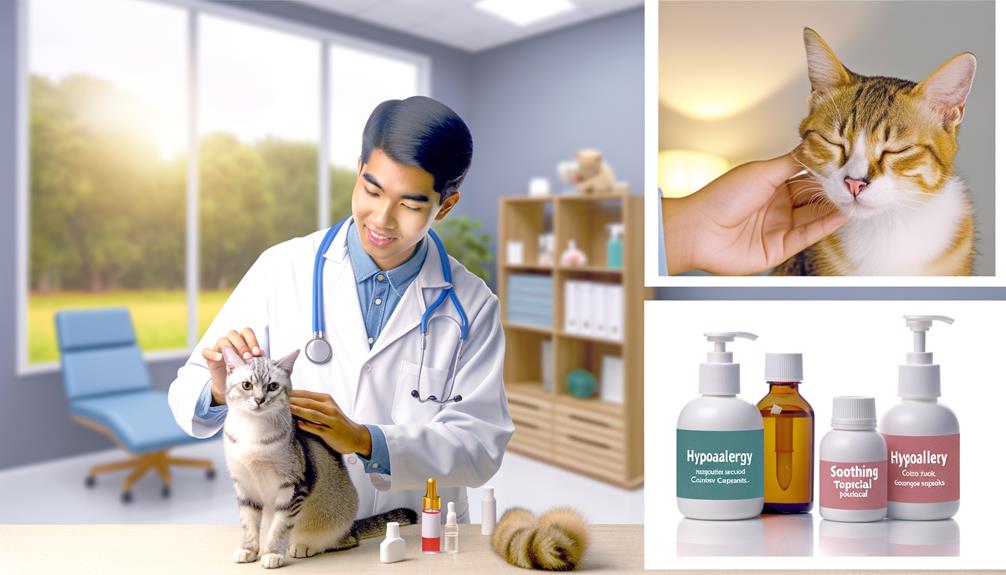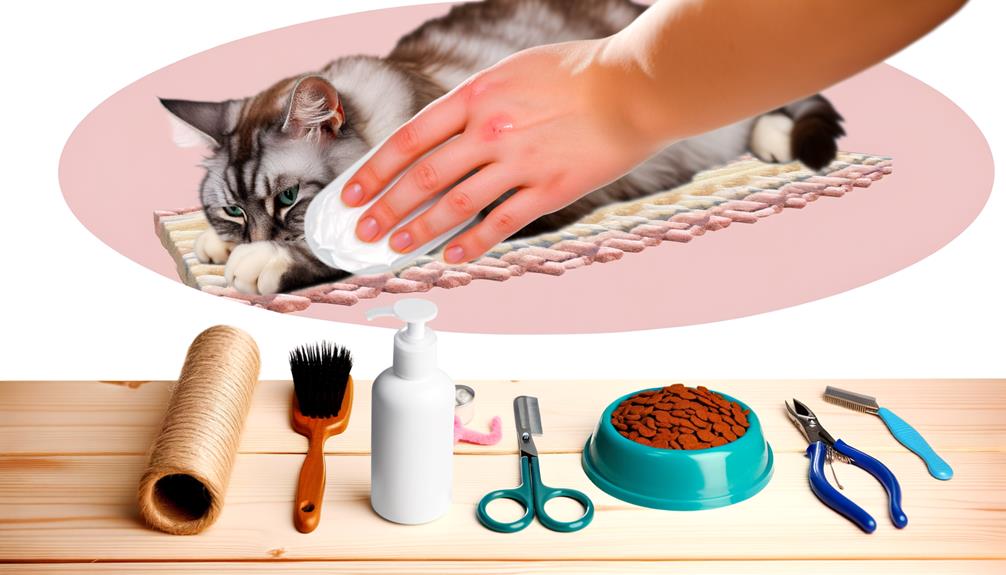Dealing with a cat's skin allergies can be challenging, but understanding the different types can make a significant difference. You'll first need to identify whether the allergy stems from fleas, food, or environmental factors. Once pinpointed, consistent flea control, an elimination diet, or medications like corticosteroids may be necessary. Keeping the living area clean and reducing stress are also vital. But how do you know which specific steps to take and when? Let's explore the symptoms, diagnosis methods, and treatment options to guarantee your cat gets the best care possible.
Types of Cat Skin Allergies
Although cat skin allergies can be quite distressing for both pets and their owners, understanding the different types is vital for effective treatment. The four primary types of cat skin allergies are Flea Allergy Dermatitis (FAD), food allergies, environmental allergies (atopic dermatitis), and contact allergies, each caused by different allergens.
Flea Allergy Dermatitis is the most prevalent, often resulting in severe itching and skin lesions due to a cat's hypersensitive reaction to flea saliva. Strict flea control measures, including topical treatments, oral medications, and environmental decontamination, are essential in managing FAD.
Food allergies in cats typically stem from specific protein sources like chicken, turkey, or beef. These allergens provoke both itching and gastrointestinal issues such as vomiting or diarrhea. An elimination diet, where suspected allergens are removed and gradually reintroduced, helps identify the offending food. Once identified, a hypoallergenic diet should be maintained.
Environmental allergies, or atopic dermatitis, are frequently seasonal. Common allergens include pollen, dust mites, and mold, leading to chronic itching and skin inflammation. Management often involves antihistamines, corticosteroids, or immunotherapy to desensitize the cat to specific allergens.
Contact allergies, though least common, occur when a cat's skin reacts to irritants such as certain fabrics, shampoos, or household chemicals. The primary treatment involves identifying and eliminating the irritant. Topical corticosteroids may be used to reduce localized inflammation and itching.
Proper diagnosis and treatment protocols for each allergy type can greatly improve your cat's comfort and health. Consultation with a veterinarian is vital to develop a tailored management plan for your pet's specific needs.
Symptoms of Skin Allergies

Skin allergies in cats typically present a variety of clinical symptoms that signal the need for medical attention. One of the most common symptoms is intense itching, causing your cat to scratch and groom excessively. This can lead to hair loss and the development of skin lesions. You'll often notice red, inflamed skin, especially on the back, neck, and ears. These areas may also develop crusts or scabs, indicating localized irritation.
Ear infections are another frequently observed symptom of skin allergies. If your cat is persistently shaking its head or scratching at its ears, this could be a sign of discomfort due to an allergy. The ears might appear red and painful, requiring immediate treatment. Flea allergies can exacerbate these symptoms, and you might see visible fleas or flea dirt on your cat, adding to the itching and skin irritation.
In some instances, skin allergies can also present with gastrointestinal issues like vomiting or diarrhea, especially in cases involving food allergies. These symptoms necessitate a thorough evaluation to determine the underlying cause and appropriate treatment.
Here's a table to help you identify key symptoms and related observations:
| Symptom | Description | Observations |
|---|---|---|
| Itching | Excessive scratching and grooming | Common with all allergies |
| Hair loss | Result of constant scratching | Localized or generalized |
| Red inflamed skin | Redness and inflammation | Often on back, neck, ears |
| Ear infections | Red, painful ears, head shaking | Persistent scratching |
| Gastrointestinal issues | Vomiting, diarrhea | Common in food allergies |
Recognizing these symptoms early on is essential for effective treatment and management of your cat's skin allergies.
Diagnosing Allergies in Cats

Identifying the root cause of your cat's skin allergies is essential for effective treatment. A thorough veterinary examination is your first step. Your vet will gather a detailed history of your cat's symptoms, such as when they occur and any potential environmental changes. This extensive approach helps narrow down possible allergens.
Diagnostic tests play a vital role in pinpointing the specific cause of skin allergies. Your vet may perform skin scrapings and impression tests to identify parasitic or bacterial infections contributing to the symptoms. For more precise allergy testing, blood tests and intradermal skin tests can reveal sensitivities to particular allergens.
When food allergies are suspected, elimination diets are often employed. This involves placing your cat on a strict hypoallergenic diet for 8-12 weeks. During this period, close adherence is essential to accurately assess your cat's response. Any improvement or recurrence of symptoms upon reintroduction of previous foods can confirm food allergies.
Flea allergy dermatitis (FAD) is another common cause of skin issues in cats. Careful observation for physical signs like hair loss, red inflamed skin, and the presence of fleas or flea dirt can aid in its diagnosis. Flea control measures are critical to rule out FAD as a contributing factor.
Collaboration with your veterinarian guarantees a tailored approach to diagnosis. By considering all potential allergens and utilizing appropriate diagnostic tests, your vet can develop a treatment plan specifically designed for your cat's needs. This thorough diagnostic process is vital to effectively managing and alleviating your cat's skin allergies.
Treatment Options

When treating a cat with skin allergies, a multifaceted approach is often necessary to effectively alleviate symptoms and improve your cat's quality of life. The following treatment options can notably help manage and reduce the discomfort associated with skin allergies.
- Flea control: Essential for treating flea allergy dermatitis, the consistent use of veterinarian-recommended topical or oral flea prevention products can considerably reduce symptoms. Flea control is vital since flea bites can exacerbate other skin conditions.
- Elimination diets: Important for managing food allergies, these diets should be followed rigorously for 8-12 weeks to identify specific food allergens. This involves feeding your cat a novel protein or hydrolyzed diet, ensuring no other food sources are available.
- Corticosteroids: Often prescribed to provide immediate itching relief and reduce inflammation related to skin allergies. While effective, long-term use should be monitored to avoid potential side effects such as immunosuppression or diabetes.
- Antihistamines and fatty acid supplements: These can be used to manage mild allergic reactions and improve the skin's condition. Though not as potent as corticosteroids, antihistamines can be beneficial in combination with other treatments, and fatty acid supplements enhance skin barrier function.
- Immunotherapy: Allergen-specific immunotherapy, including allergy shots, can be considered for long-term management. This treatment gradually reprograms the immune system, reducing sensitivity to identified allergens over time.
Ongoing Management Strategies

Maintaining effective control of a cat's skin allergies necessitates an all-encompassing approach that integrates regular veterinary care and environmental management. Regular veterinary check-ups are essential for monitoring your cat's condition, adjusting treatment plans, and guaranteeing effective management of skin allergies in cats. Your vet might prescribe treatments tailored to your cat's specific needs, whether it's antihistamines, corticosteroids, or topical ointments.
A clean living environment is critical. Frequent vacuuming and washing of bedding can considerably reduce allergen exposure. This minimizes flare-ups and maintains a healthy atmosphere for your cat. Consistent flea control is another fundamental component. Flea allergies can exacerbate skin issues, so use veterinarian-recommended flea prevention products diligently.
Dietary management plays a vital role. An elimination diet can help identify and manage food allergies for cats. Stick to a strict hypoallergenic diet and monitor any treats or additional foods introduced to confirm they don't trigger allergic reactions. This requires meticulous attention to detail and regular consultations with your vet to adjust the diet as needed.
Stress reduction techniques are equally important. A calm environment, coupled with interactive play, can help minimize allergic reactions. Stress can worsen skin conditions, so providing a peaceful setting and engaging your cat in stimulating activities is beneficial.
Ongoing treatment for cats with skin allergies involves a multifaceted approach. Monitoring your cat's progress and making necessary adjustments, while maintaining a clean and stress-free environment, is vital. With a diligent approach, you can effectively manage your cat's skin allergies and improve their overall quality of life.
